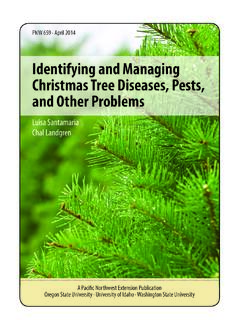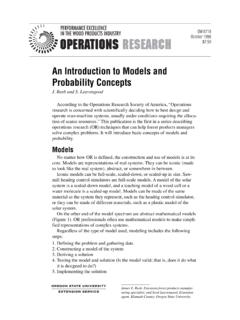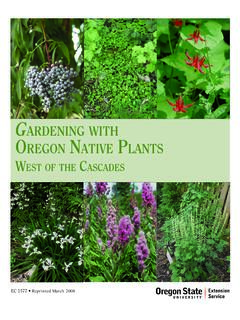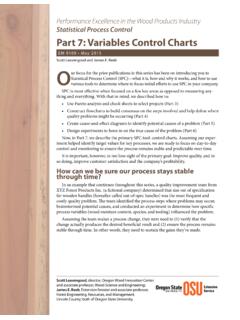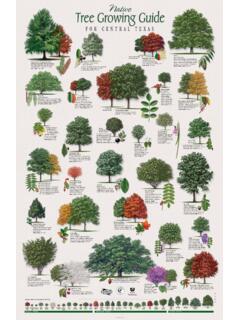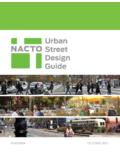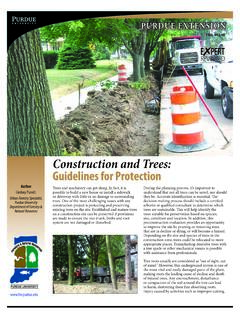Transcription of Tree protection on construction and development sites
1 tree protection on construction and development SitesEM 8994 December 2009A Best Management Practices Guidebook for the Pacific Northwestprotect forest remnant stands ..2 Excellent Stand protection ZonePoor Stand protection ZoneBMPs for Protecting Native Forest Remnantsprotect individual trees ..3 Why Protect TreesTree protection TechniquesCritical Root Zone ProtectionBMPs for tree Protectionchanging grade around trees ..8 Raising the Existing GradeLowering the Existing GradeTrenchingmaintain trees properly ..10 Don t Top Trees! tree MaintenanceBMPs for tree PruningProper tree Removal and ReplacementBMPs for tree Removal and Replacementplanting & establishing new trees ..14 Proper tree PlantingBMPs for tree Establishmentintroduction.
2 1 What s at StakePurpose of GuidebookWho Should Use This Guidebookcontents1introductionINTRODUCTI ONWhat s at StakeUrban forests consist of the native forest remnants and the planted forested land-scapes in our urban forest is a valuable resource that provides economic, environmental, and social benefits. Quality of life in cities is enhanced when we have a canopy of trees shading our homes and streets, miti-gating stormwater effects, providing energy savings, and improving property values. Research by the USDA Forest Service indicates that, for every $1 spent on urban trees, $ in benefits is forests in the Pacific Northwest become more fragmented through urbanization and development , we lose a significant amount of the ecosystem services that forests provide, such as storm-water and flood control, and mitigation of greenhouse guidebook is designed to help the user retain healthy trees that contribute these services and of GuidebookThis publication is a guide for protecting, conserv-ing, selecting, maintaining, removing, and replacing trees on development sites in the Pacific Northwest.
3 The guidebook is designed to assist people who work with trees during the development and construction phases of both new and existing projects to keep healthy trees a part of the urban environment through the use of accepted tree care standards and publication provides best management prac-tices (BMPs) developed and recommended by pro-fessional arborists, urban and community foresters, and landscape architects. BMPs are widely accepted practices and standards used by industry profession-als and based on the best available research. The guidebook provides basic and practical information about methods to give trees planted or retained on development sites the best chance to survive and thrive during and after the construction process.
4 Please note that while the BMPs in this guidebook are widely accepted practices and standards, they don t guarantee 100% successful tree these practices are presented here as voluntary guidelines, some local jurisdictions have tree protection regulations that must be followed. Contact your local planning department for specific regulations for your area. Who Should Use This GuidebookThis guidebook is intended to support the building, development , and construction industries. If you are a construction contrac-tor or employee, builder or land developer, heavy equipment operator, landscape maintenance contractor or employee, tree care service contractor or employee, or utility employee, this guidebook is for you.
5 You are an important part of successful tree protection efforts!This publication will also be helpful to engineers, landscape architects, and planners that are involved in planning and designing construction projects. It can be used as a project planning and implementation tool, as well as a resource for community guidelines in this publication could make a significant difference to your con-struction site for years to come. Trees that are treated as assets rather than liabilities may save thousands of dollars on a project through reduced stormwater infrastructure needs and increased property forest remnant stands2 PROTECT FOREST REMNANT STANDSS tands, groves, or patches of native Pacific Northwest trees, such as Oregon white oak, Western red cedar, red alder, bigleaf maple, and Douglas-fir, are often found in urban or urbanizing areas.
6 These ecosystems are remnants of the larger forests that previously covered the area. They may range from less than a quarter acre to several acres in size. Conservation of existing groves of native trees often provides greater economic and environmental benefit than preserv-ing individual trees in the developing Stand protection ZoneHigh tree densities with an undisturbed understory are characteris-tics of a high-quality forest remnant worth preserving. An excellent stand protection zone has the following characteristics: Trees structurally support one another. Soil remains undisturbed. Wildlife uses are relatively unimpaired. Shady microclimate encourages natural woodland plants. Natural forest succession continues and forest regeneration is ongoing.
7 The stand is visually attractive. Ecological functions are relatively stand to protect. Reproduced with permission by the City of Stand protection ZoneScattered trees with a highly disturbed or missing understory may not be worth saving. A poor stand protection zone has the following characteristics: Trees blow over easily due to lack of support. Soil dries out and soil erosion occurs due to disturbed soils and lack of understory. Forest microclimate is disturbed. Sunlight and temperature increase. Weeds and invasive species take over. Forest succession is interrupted and little regeneration occurs. The stand is visually unattractive. Ecological functions are severely for Protecting Native Forest Remnants Fence the entire stand, grove, or patch to protect understory vegetation and soil as well as trees.
8 Healthy soils require little if any fertilization, pesticides, or irrigation to support tree health. Avoid removing vigorous, healthy trees and vegetation from the stand. Do not retain isolated single, tall, spindly trees; such trees are more likely to become structurally unstable, bend or blow over in storms, or become diseased and/or infested with insects. Avoid creating new forest edges that may not be wind-firm; retain large trees that are on the windward side of a stand to provide sup-port and protection to the interior of the stand that may not be worth saving. Reproduced with permission by the City of individual treesPROTECT INDIVIDUAL TREESWhy Protect TreesTrees should be protected throughout their lives from damage to maximize their health, safety, functionality, and benefits.
9 Young, newly planted trees need protection as much as large, mature trees in new and existing developments reduces long-term tree maintenance and replacement costs; reduces site preparation and grading costs; provides immediate aesthetic and economic benefits because properties with more mature trees and greater tree canopy cover sell faster and accrue property value faster in comparison to properties without these assets; generates positive response from neighbors and the surround-ing community; generates good public relations; and provides healthier trees, forest ecosystem, and environment for a healthier, safer, more vital protection TechniquesTree protection involves activities designed to preserve and protect tree health by avoiding damage to tree roots, trunk, or crown.
10 Site development planning prior to site disturbance should include identifying tree protection zones (TPZs) for all trees designated for protection may be passive or active. Passive tree protection , most commonly used during the planning or post- development stages, simply means avoiding any disturbance or harmful activity near the tree . Active tree protection , by contrast, involves physical protective barriers and is generally required during any site disturbance that may impact retained trees, such as grading, building construction and maintenance, infrastructure and utility installation and maintenance, and other landscape changes that may affect the structural integrity and stability of retained trees. Critical Root Zone ProtectionA critical step in retaining healthy trees during construction and development is the protection of tree roots from disturbance.
